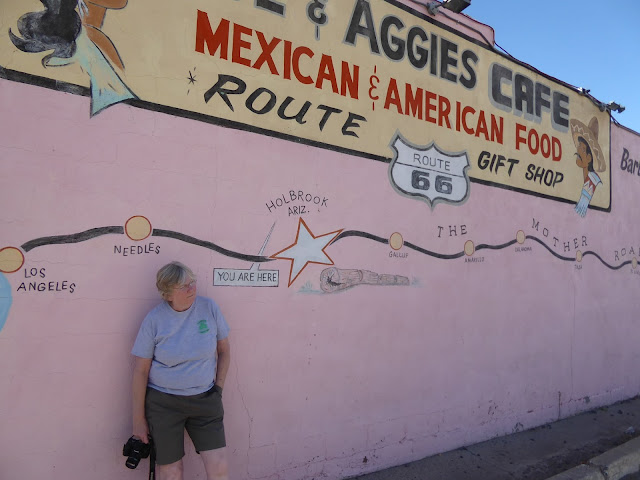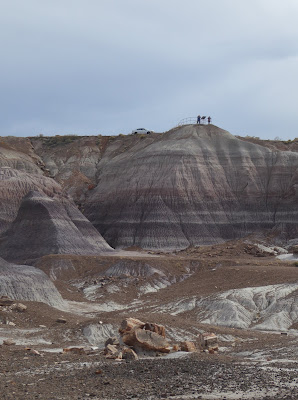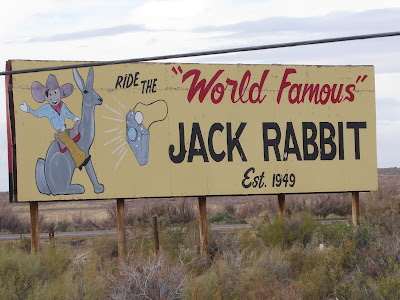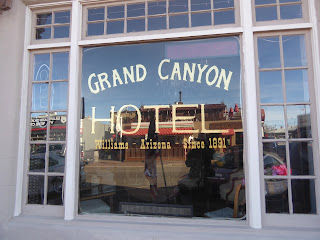Our last few miles of Route 66 in New Mexico were scenic, winding up the sheer side of Devil’s Cliff. The state line at Lupton, Arizona has long been home to colorful trading posts.
On our detour north we’d seen billboards for McDonald’s 80 miles apart. We therefore knew that McDonald’s was the modern scale for judging the size of a town. But for much of this day we saw tacky billboards from the old Route 66 days, as we followed the Little Colorado River—and, inevitably, I-40.
One section of the 1926-31 highway remains that was worth doing: a dirt county road over the Querino Canyon Bridge.
The Petrified Forest is the one national park that Route 66 actually crossed. Today it’s crossed by the interstate, too, though there’s no access at that point. We exited I-40 north of the park and entered via the Painted Desert, an area of badlands.
Perhaps because it was a cloudy day, T. was less impressed by the Painted Desert than I remembered being in 1987. She compared it to a slag heap. The sun does help to bring out the colors. Fortunately, in the parking lot, we happened to be in time for the U.S. Capitol Christmas Tree, which was making lots of stops in its big truck en route to Washington, D.C.
The Painted Desert Inn is now a museum and, like many other attractions along our route, was closed that day. Most of my interest was in the outside of the building though. It dates from 1924 and was built in Pueblo Revival style, and before it closed in 1942, it was managed by Fred Harvey’s company as a hotel for passengers on the Santa Fe Railroad, which we’d been following for some days.
The Painted Desert Inn was also our first look at the work of Mary Jane Colter, an important architect of the Southwest who, among other things, put in the glass to connect the building with the landscape. There are other interesting details such as the use of petrified wood.
A line of telephone poles indicates where Route 66 once passed right through, delivering travelers their first sight of the national park. The old alignment is marked by a 1932 Studebaker.
Having been through the “quarry” that T. called the Painted Desert, we entered the Petrified Forest. The view of “Newspaper Rock” showed us more impressive relics of an ancient civilization.
Annie Alexander, pioneer paleontologist, 1921
I was relieved to see the sun come out for our walk on the Blue Mesa Trail. It’s only a mile loop and paved with asphalt, but descends dramatically in among the petrified wood.
 |
| "Elephant skin" surface |
 |
| Mesa with train |
At the park exit stands one of the oldest national park buildings. We got a taste of what’s to come when we learned the plumbing wasn’t up to visitors. Lots of port-o-pots in our future.
We were now south of the park, and rather than backtrack 28 miles merely to get back on the interstate, elected to turn on U.S. 180 and rejoin Route 66 at Holbrook.
 |
 |
| Joe and Aggie's, also closed |
West of Holbrook, the Geronimo Trading Post advertised the “World’s Largest Petrified Tree.” It’s in pieces and T. was less than impressed. A more interesting use of petrified wood was in the welcome sign to Joseph City, named after Joseph Smith, the founder of the Church of Jesus Christ of Latter-day Saints.
Our destination for the night was Winslow, of which people of many nationalities have sung along to the Eagles’ “Take It Easy.” However, there were still a number of old signs to follow, culminating in a rough section of frontage road with grass growing on it. This led to the Jackrabbit Trading Post.
In its heyday, Route 66 had more than a thousand miles of signs telling people how far it was to the Jackrabbit—starting at Springfield, Missouri! Heaven knows how the owner afforded it, but the Jackrabbit Trading Post became a must-visit destination by the time people finally arrived, and it’s still there, and it was open.
 |
| Note little jackrabbits all along the top! |
T’s highlight, though, which she’d been talking about for days, was Standin’ on the Corner in Winslow, Arizona, a statue of Glenn Frey by Ron Adamson. And a mural, and a park, and the biggest Route 66 shield ever painted on the intersection.
Frey and Jackson Browne wrote the song following Browne’s trip on Route 66:
"Well, I'm a-standin' on a corner in Winslow, Arizona.
Such a fine sight to see.
It's a girl, my lord, in a flatbed Ford,
slowin' down to take a look at me."
It was all buildup to our resting place for the night: La Posada. The last of the Fred Harvey hotels that once welcomed train passengers from Cleveland to California, and the masterpiece of Mary Jane Colter.
Unlike other Harvey Houses which are either closed or demolished, La Posada (1928) is beautifully restored. You can still board Amtrak trains behind the hotel. We stayed in the “Douglas Fairbanks” room, and it had a library!
The Harvey Houses have a special place in history because of the Harvey Girls, as the young hostesses who worked in the hotels were called (also a Judy Garland film). Young women, many of them immigrants, traveled across the country to work as waitresses, an unusually independent thing to do at the time. Harvey Houses also had the distinction of never being segregated, so La Posada is one of the few places in Arizona still open today that welcomed black travelers in the era of the Green Book.
I was kind of reluctant to leave the next morning. Everything about the hotel and grounds was beautiful.
 |
| Pollinator garden |
 |
| Sunset, train stop behind La Posada |
But, we’d heard that west of Winslow and just a few miles off Route 66 was the Meteor Crater. You had to see the Meteor Crater (as my grandpa told us in 1987 about Lake Havasu). So, we ignored the navigation app’s warnings not to deviate from the Route. “Jane, you’re *!@?$! barking mad,” T. told her genially.

At last, we were there.
The impact of 150 atomic bombs’ worth of energy is an impressive fact. If this collision had happened more recently than 50,000 years ago, a whole city could have been destroyed. (“There probably were people living there 50,000 years ago,” T. said, “and that’s probably why they started living in *!@?$! caves!”) What was not impressive was the $20 (for a senior!) per person charge to go in the museum, which no doubt told more about the use of the crater for moon landing practice. What if you had a family of kids who were really interested in the museum? Who could afford this? For $20, your whole carload could visit the national parks for an entire day.
We could have turned around and not seen the meteor crater, but I knew, even as we paid, that I’d get much more pleasure out of telling everyone what a ripoff it was.
Back on Route 66 were some ruins along dead-end frontage road. Two Guns was once a Wild West theme park with one of Route 66’s dubious roadside zoos.
Twin Arrows, an old trading post made iconic by these two telephone poles in 1955, is also abandoned and otherwise covered with graffiti. The arrows themselves have been repainted by the Hopi tribe, whose land this is.
The Route 66 song says “Don’t forget Winona,” rhyming it with Flagstaff, Arizona. It would be almost as easy to miss Winona today as Two Guns or Twin Arrows, but we didn’t, taking the Townsend-Winona Road which was the pre-1947 alignment. Winona still has a truss bridge closed to motor traffic, and we saw a jackrabbit cross the road (a real one!)
To the north of us, a train climbed up a steep grade. Flagstaff is much livelier than Winona and presented us with many historic reminders.
 |
| Ponderosa pine frames the doorway of the Museum Club (1931) |
Downtown Flagstaff is compact and provided us with a delightful self-guided walking tour.
 |
| Orpheum Theater, 1917 |
Further west, a pre-1941 gravel detour took us to Parks.
The Parks in the Pines General Store and Post Office is still lively and operating. The original (1926-31) alignment of Route 66 was one block south, on the other side of the building. According to Jessica Dunham, the store kept up with the realignment by moving the front entrance to what had been the back door.
Williams, Arizona was the last town bypassed by Route 66 on October 13, 1984. There’s still a mural in the town commemorating this dark day. The citizens fought hard to preserve downtown Williams’s heritage as a Route 66 stop.
We were starving, so we stopped, as you do, in an 1897 bordello. The Red Garter Inn isn’t so much a saloon today as a nice diner.
The scenic (and expensive!) thing to do from Williams is to take a special train to the Grand Canyon. We’ve been to the Grand Canyon multiple times and were not doing this, but as we walked towards the railroad, I heard a woman say to T., “You’re in shorts and a T-shirt and I’m freezing in a jacket!”
She sure sounded familiar to me, and I wasn’t surprised when she said, “We’re from Tennessee.” I asked her where and she said near Knoxville. When I told her where I grew up, she said “Oh—we’re from Kingsport! I just didn’t know if you’d know where that was.”
This was what I always thought when I used to tell people where I was from too. The couple was in Williams for a five-day trip, and if they were taking the Grand Canyon Railway, it must have been a memorable one.
From there we had to get back on the interstate for what T. termed “a rapid descent, not as rapid as the meteor!”
The town of Ash Fork, the flagstone capital of America, was cut off by I-40. One man trying to change that is an Airbnb owner who stopped to talk to us while we were taking pictures of his place.
He told us that this old gas station is now his Airbnb, and they’re trying to restore more properties along the main drag of Ash Fork, so that it’s a worthy Route 66 stop like Williams.
Route 66 still exists as a historic and beloved route because of people like this man. Perhaps no one, though, deserves more credit than the founders of the Historic Route 66 Association of Arizona, which led to the foundation of other state organizations and made much of our trip possible.
 |
| Cutout of Angel Delgadillo with his barber chair! |
Angel Delgadillo and his family, in the next town of Seligman, didn’t want their town to die. Thanks to their hard work and inspiration for others, there are now 159 miles of non-interstate Route 66 that you can drive through northern Arizona, beautiful and in good shape. There are series of replica Burma-Shave signs along the Crookton Road all the way to Seligman.
We didn’t actually meet Angel Delgadillo, but we did visit his barbershop, now a visitor center.
Still following recommendations from Lile in Amarillo, we had dinner at the Roadkill Café (we had salad, so as to avoid roadkill, and leave room for pie!) There was a discount because we were staying next door at the Historic Route 66 Motel.
Seligman’s main street has lots of good businesses and some old neon too. The Stagecoach motel is run by Norwegians and has a big Norwegian flag out front. There’s another place run by Germans and advertising good hamburgers (naturally). Seligman is a favorite place of Route 66 travelers from all over the world.
Not quite Douglas Fairbanks
I got to talking to our next door neighbor at the motel, which is a Route 66 thing to do. I couldn’t guess her age, but I wouldn’t have thought, had she not told us, that she’d restored her own vintage Porsche and was now driving it all over the country by herself.
And I don’t have a picture, but the starry sky at night over Seligman was better than I saw anywhere else on the trip—even the national parks.



















































1 comment:
In this fascinating blog about your "kicks on Route 66," we particularly enjoyed learning more about the Harvey Houses, their "never being segregated," and the one surviving member, the La Posada Hotel: "Everything about the hotel and grounds was beautiful." P & G
Post a Comment